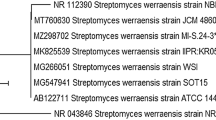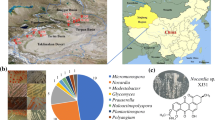Abstract
The rare actinomycetes strain 2EPS was isolated from soil and analysis of cultural, morphological characteristics, diaminopimelic acid content of its cell wall, and 16S rRNA gene sequence indicates that 2EPS belongs to genus Actinomadura. In addition, neighbor-joining phylogenetic tree also confirmed the relationships of this strain to other members of Actinomadura. A butanol extract with antibacterial activity was purified by reversed-phase chromatography to obtain three bioactive compounds, designated as compounds 1, 2 and 3. The structures of these compounds were determined using spectroscopic analysis (1H-NMR and 13C-NMR) and mass spectrometric analysis (HR-TOF-MS). Compounds 1–3 were identified and found to be the same as those included in the Japanese patent number JP 09227587 for spirotetronate antibiotics and are BE-45722A (1), BE-45722B (2) and BE-45722C (3), respectively. All compounds were active against Gram-positive bacteria (Staphylococcus aureus ATCC 25923, Bacillus cereus ATCC 14579, and B. subtilis ATCC 6633) with low MIC values between 0.08 and 5.0 µg/ml. Moreover, both 1 and 3 also exhibited strong activity, with similar MIC values, against Clostridium perfringens S107 at 0.63 µg/ml and C. difficile 630 at 0.08 µg/ml. These results suggest the identified spirotetronate compounds may have potential in the treatment of Clostridium infections. Overall, this analysis demonstrates that rare actinomycetes are a promising source for discovery of antimicrobial compounds.



Similar content being viewed by others
References
Akama S, Arai Y, Yamamoto H, Akaishi S (1998) Antibacterial substances of Actinomadura species TA-0327. Japan Patent JP 10273497, 13 Oct 1998
Bartlett JG (2010) Clostridium difficile: progress and challenges. Ann N Y Acad Sci 1213:62–69
Becker B, Lechevalier MP, Lechevalier HA (1965) Chemical composition of cell-wall preparation from strains of various form-genera of aerobic actinomycetes. Appl Microbiol 13:236–243
Bérdy J (2005) Bioactive microbial metabolites. J Antibiot 58:1–28
Bérdy J (2012) Thoughts and facts about antibiotics: where we are now and where we are heading? J Antibiot 65:385–395
Chankhamhaengdecha S, Hadpanus P, Aroonnual A, Ngamwongsatit P, Chotiprasitsakul D, Chongtrakool P, Janvilisri T (2013) Evaluation of multiplex PCR with enhanced spore germination for detection of Clostridium difficile from stool samples of the hospitalized patients. Biomed Res Int 2013:1–6
Cook AE, Roes MI, Meyers PR (2005) Actinomadura napierensis sp. nov., isolated from soil in South Africa. Int J Syst Evol Microbiol 55:703–706
Fitch WM (1971) Toward defining the course of evolution: minimum change for a specific tree topology. Syst Biol 20:406–416
Grass JE, Gould LH, Mahon BE (2013) Epidemiology of foodborne disease outbreaks caused by Clostridium perfringens, United States, 1998–2010. Foodborne Pathog Dis 10:131–136
Hayakawa M, Sadakata T, Kajiura T, Nonomura H (1991) New methods for the highly selective isolation of Micromonospora and Microbispora from soil. J Ferment Bioeng 72:320–326
He M, Miyajima F, Roberts P, Ellison L, Pickard DJ, Martin MJ, Connor TR, Harris SR, Fairley D, Bamford KB, D’Arc S, Brazier J, Brown D, Coia JE, Douce G, Gerding D, Kim HJ, Koh TH, Kato H, Senoh M, Louie T, Michell S, Butt E, Peacock SJ, Brown NM, Riley T, Songer G, Wilcox M, Pirmohamed M, Kuijper E, Hawkey P, Wren BW, Dougan G, Parkhill J, Lawley TD (2013) Emergence and global spread of epidemic healthcare-associated Clostridium difficile. Nat Genet 45:109–113
Jia X-Y, Tian Z-H, Shao L, Qu X-D, Zhao Q-F, Tang J, Tang G-L, Liu W (2006) Genetic characterization of the chlorothricin gene cluster as a model for spirotetronate antibiotic biosynthesis. Chem Biol 13:575–585
Kelly CP, LaMont JT (2008) Clostridium difficile—more difficult than ever. N Engl J Med 359:1932–1940
Kim OS, Cho YJ, Lee K, Yoon SH, Kim M, Na H, Park S-C, Jeon YS, Lee JH, Yi H, Won S, Chun J (2012) Introducing EzTaxon-e: a prokaryotic 16S rRNA gene sequence database with phylotypes that represent uncultured species. Int J Syst Evol Microbiol 62:716–721
Kotoda N, Shin-Ya K, Furihata K, Hayakawa Y, Seto H (1997) Isolation and structure elucidation of novel neuronal cell protecting substances, carbazomadurins A and B produced by Actinomadura madurae. J Antibiot 50:770–772
Lam KS, Hesler GA, Gustavson DR, Berry RI, Tomita K, Macbeth JI, Ross J, Miller D, Forenza S (1996) Pyrrolosporin A, a new antitumor antibiotic from Micromonospora sp. C39217-R109-7 I. Taxonomy of producing organism, fermentation and biological activity. J Antibiot 49:860–864
Lechevalier HA, Lechevalier MP (1970a) A critical evaluation of the genera of aerobic actinomycetes. In: Prauser H (ed) The Actinomycetales. VEB Gustav Fischer Verlag, Jena, pp 393–405
Lechevalier MP, Lechevalier H (1970b) Chemical composition as a criterion in the classification of aerobic actenomycetes. Int J Syst Microbiol 20:435–443
Lee SD (2012) Actinomadura rupiterrae sp. nov., isolated from cliff soil. Int J Syst Evol Microbiol 62:990–995
Mathura H, O’Connor PM, Hilla C, Cotter PD, Ross RP (2013) Analysis of anti-Clostridium difficile activity of thuricin CD, vancomycin, metronidazole, ramoplanin, and actagardine, both singly and in paired combinations. Antimicrob Agents Chemother 57:2882–2886
Mazzetti C, Ornaghi M, Gaspari E, Parapini S, Maffioli S, Sosio M, Donadio S (2012) Halogenated spirotetronates from Actinoallomurus. J Nat Prod 75:1044–1050
Miyadoh S (1993) Research on antibiotic screening in Japan over the last decade: a producing microorganism approach. Actinomycetologica 7:100–106
Momose I, Hirosawa S, Nakamura H, Naganawa H, Iinuma H, Ikeda D, Takeuchi T (1999a) Decatromicins A and B, new antibiotics produced by Actinomadura sp. MK73-NF4. II. Structure determination. J Antibiot 52:787–796
Momose I, Iinuma H, Kinoshita N, Momose Y, Kunimoto S, Hamada M, Takeuchi T (1999b) Decatromicins A and B, new antibiotics produced by Actinomadura sp. MK73-NF4 I. Taxonomy, isolation, physico-chemical properties and biological activities. J Antibiot 52:781–786
Rzhetsky A, Nei M (1993) Theoretical foundation of the minimum-evolution method of phylogenetic inference. Mol Bio Evol 10:1073–1095
Saito H, Miura KI (1963) Preparation of transforming deoxyribonucleic acid by phenol treatment. Biochim Biophys Acta 72:619–629
Saitou N, Nei M (1987) The neighbor-joining method: a new method for reconstructing phylogenetic trees. Mol Biol Evol 4:406–425
Senesi S, Ghelardi E (2010) Production, secretion and biological activity of Bacillus cereus enterotoxins. Toxins 2:1690–1703
Shirling EB, Gottlieb D (1966) Methods for characterization of Streptomyces species. Int J Syst Microbiol 16:313–340
Sripreechasak P, Tanasupawat S, Suwanborirux K, Inahashi Y, Matsumoto A, Shiomi K, Takahashi Y (2013) Nonomuraea thailandensis sp. nov. isolated from Thai soil. J Antibiot 66:79–84
Tajima K, Takahashi Y, Seino A, Iwai Y, Omura S et al (2001) Description of two novel species of the genus Kitasatospora Omura et al. 1982, Kitasatospora cineracea sp. nov. and Kitasatospora niigatensis sp. nov. Int J Syst Evol Microbiol 51:1765–1771
Tamura K, Dudley J, Nei M, Kumar S (2007) MEGA4: molecular evolutionary genetics analysis (MEGA) software version 4.0. Mol Bio Evol 24:1596–1599
Tao W, Zhu M, Deng Z, Sun Y (2013) Biosynthesis of tetronate antibiotics: a growing family of natural products with broad biological activities. Sci China Chem 56:1364–1371
Tomita F, Tamaoki T (1980) Tetrocarcins, novel antitumor antibiotics. I. Producing organism, fermentation and antimicrobial activity. J Antibiot 33:940–945
Torigoe K, Nakajima S, Suzuki H, Nagashima M, Ojiri K, Suda H (1997) Antibacterial BE-45722-group substances, their manufacture with Actinomadura, bactericides containing them, and Actinomadura producing them. Japan Patent JP 09227587, 26 Feb 1996
Trujillo ME, Goodfellow M (2012) Genus III. Actinomadura. In: Goodfellow M, Kämpfer P, Busse H-J, Trujillo ME, Suzuki K-i, Ludwig W, Whitman WB (eds) Bergy’s manual of systematic bacteriology: the actinobacteria, Part B. vol 5, 2nd edn. Springer, New York, pp 1940–1958
Waitz JA, Horan AC, Kalyanpur M, Lee BK, Loebenberg D, Marquez JA, Miller G, Patel MG (1981) Kijanimicin (Sch 25663), a novel antibiotic produced by Actinomadura kijaniata SCC 1256. Fermentation, isolation, characterization and biological properties. J Antibiot 34:1101–1106
Walsh C (2003a) Antibiotics: action, origins, resistance. ASM Press, Washington
Walsh C (2003b) Where will new antibiotics come from? Nat Rev Microbiol 1:65–70
Wiegand I, Hilpert K, Hancock REW (2008) Agar and broth dilution methods to determine the minimal inhibitory concentration (MIC) of antimicrobial substances. Nat Protoc 3:163–175
Zhi X-Y, Li W-J, Stackebrandt E (2001) An update of the structure and 16S rRNA gene sequence-based definition of higher ranks of the class Actinobacteria, with the proposal of two new suborders and four new families and emended descriptions of the existing higher taxa. Int J Syst Evol Microbiol 51:373–383
Zhi X-Y, Li W-J, Stackebrandt E (2009) An update of the structure and 16S rRNA gene sequence-based definition of higher ranks of the class Actinobacteria, with the proposal of two new suborders and four new families and emended descriptions of the existing higher taxa. Int J Syst Evol Microbiol 59:589–608
Acknowledgments
This study was supported by Thailand Research Fund through the Royal Golden Jubilee Ph.D. Program (Grant No. Ph.D/0103/2552) to JE and WP and by the scholarship from the Japan Student Services Organization (JASSO) to JE. We are grateful to Dr. Laran T. Jensen (Department of Biochemistry, Faculty of Science, Mahidol University) for critically proofreading of the manuscript.
Author information
Authors and Affiliations
Corresponding author
Electronic supplementary material
Below is the link to the electronic supplementary material.
Rights and permissions
About this article
Cite this article
Euanorasetr, J., Intra, B., Mongkol, P. et al. Spirotetronate antibiotics with anti-Clostridium activity from Actinomadura sp. 2EPS. World J Microbiol Biotechnol 31, 391–398 (2015). https://doi.org/10.1007/s11274-014-1792-z
Received:
Accepted:
Published:
Issue Date:
DOI: https://doi.org/10.1007/s11274-014-1792-z




